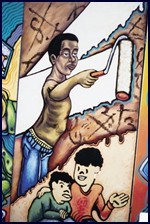


|
This section includes information about the costs of running an arts program, how to develop your budget, and funding opportunities. For more about these topics and about advocating for program resources, download the chapter or the full YouthARTS handbook in PDF format. Doing the mathHow much does it cost to run an arts program for youth at risk? Americans for the Arts, working with the President's Committee on the Arts and the Humanities, conducted in-depth interviews with staff from 218 afterschool arts programs for youth at risk. The annual budgets for these programs varied dramatically, from $4,355 to $3 million; the average annual program budget was $158,537, and the median budget was $84,000 (one-half of the programs were above this amount and one-half below this amount). The expenses include administrative staff, artists, art supplies, team training, food, nutrition, and evaluation. How do the costs for running a youth arts program compare with the costs for detention? "Young at Art," an Idaho Commission on the Arts program, calculates that its operation cost was $6.40 per day per youth, compared with the $125 a day that it costs per day for a youth in juvenile detention. Americans for the Arts reports that $7 billion is spent annually to incarcerate young offenders; the cost for incarcerating a delinquent youth for one year is at least $20,000. Programs for youth at risk vary widely—in the number of youth served, the frequency at which they meet, and so forth, making it very difficult to conduct cost-benefit analyses. However, based on a decade-long study of arts programs conducted at Stanford University, researchers Shirley Brice Heath and Adelma Aurora Roach estimate the cost per student per year for afterschool arts programs is $1,000. They also estimate projected savings to society, based on youth services, court costs, probation officers, imprisonment costs, and so forth, to be $36,000 to $100,000 annually. Where does the money come from? Ninety-five percent of the programs surveyed by Americans for the Arts have more than one source of funding. State and federal governments are a significant source of financial support for these programs. Federal funding opportunities include one-time-only funds and ongoing program funds. Here's an overview of federal funding opportunities for programs designed for youth at risk. Developing program budgetsThe YouthARTS programs operate with budgets ranging from $100,000 to $400,000 per year. All three YouthARTS programs have multiple sources of funding and support. Program resources combine cash contributions with in-kind contributions. In all three cities, the collaborative partners bring financial resources to the programs. Learn how the three YouthARTS programs used the planning model to develop their program budgets (expenditures and resources) on pages 180-188 of the full chapter PDF. See sample budgets from all three YouthARTS programs on pages 182, 185, and 188 of the full chapter PDF. Learn about advocating for program resources by visiting our Art. Ask for More website. Funding opportunities and resourcesThe funding information included on the website has been updated and is more current and accurate that what you'll find in the PDF of the orginial printed YouthARTS Toolkit. The websites for federal departments, agencies, and clearinghouses are important sources of current information about the availability of program funding, as is the Federal Register, available at all public libraries and on the GPO's official website at: www.gpo.gov/su_docs/aces/aces140.html. The following agencies provide particularly pertinent sources of information about federal support for arts programs for youth at risk: The National Endowment for the Arts (NEA) awards hundreds of grants each year to non-profit arts organizations. The NEA website (www.nea.gov) contains valuable information about the types of grants available; grant application guidelines; descriptions of current grantees; contact information for other federal, state, and local funding sources; and other up-to-date resources. To order a copy of NEA's Grants for Arts Projects Guidelines, complete the online order form, available at www.nea.gov. The U.S. Department of Education provides funding for afterschool youth activities through several programs, most notably the Safe and Drug-Free Schools and Communities Program and the 21st Century Community Learning Centers Program. Funding opportunities for education agencies working in partnership with museums, local arts agencies, and other cultural agencies are also available, including the Cultural Partnerships for At-Risk Children and Youths-Arts in Education program. Current program application information can be obtained from the department's website at www.ed.gov. The U.S. Department of Labor's Employment and Training Administration (ETA) is the source of information about funding administered by state and local governments that may be of interest to youth program administrators. The ETA website is www.doleta.gov. The U.S. Department of Health and Human Services (www.doleta.gov) maintains several national clearinghouses, two of which provide current information about programs and resources that are particularly useful to arts-based youth programs: The National Clearinghouse for Alcohol and Drug Information provides resources on drug and alcohol education, prevention, and treatment. This clearinghouse's website features federal drug prevention resources and is located at www.health.org. The National Clearinghouse on Families and Youth (www.ncfy.com/) includes resources for youth service professionals and policymakers on youth development, family services, substance abuse, runaway and homeless youth, and community schools. The Office of Juvenile Justice and Delinquency Prevention (OJJDP) administers numerous grant programs designed to support state and local nonprofit organizations in planning, implementing, and evaluating programs for at-risk youth. In addition, OJJDP also offers a wide range of training, technical assistance, and evaluation resources. To learn more about available resources, grant opportunities, and information services, visit the OJJDP website at ojjdp.ncjrs.org/. Other sources of information about funding opportunities and resources for arts programs for children and youth include:The National Funding Collaborative on Violence Prevention is a public-private partnership that "links resources to local efforts to raise public awareness that violence is preventable and to empower citizens to tackle violence in their communities." The organization pools resources from national and community foundations, corporations, the federal government, community organizations, and private donors. Visit the collaborative's website at www.nfcvp.org. The National Resource Center for Youth Services, at the University of Oklahoma, offers resources and support for professionals whose focus is youth, children, and families. The center provides on-site training services and offers a wide variety of affordable publications and videos. Its mission is to "enhance the services provided to at-risk youth and their families." For more information, see the center's website at www.nrcys.ou.edu. The National Crime Prevention Council Online Resource Center is a "national nonprofit educational organization whose mission is to help America prevent crime and build safer, stronger communities." The center's publications include several that will help you locate the resources your youth program needs through a variety of channels, as well as ideas that work for finding goods, services, people, and money to get the job done and build partnerships. For more information about the center's services, visit its website at www.ncpc.org. In addition to federal programs, there are other public and private sources that you might want to check out. According to the Foundation Center Statistical Services, the top five U.S. foundations awarding grants for the arts, culture, and humanities (circa 2000) are:
The Foundation Center further reports that the top five U.S foundations awarding grants in youth development are:
The Foundation Center maintains a complete listing of foundations nationwide and information on grants awarded from each foundation. Americans for the Arts offers a number of publications that provide information on resources for funding arts programs. They are:
These publications and others are available through the Americans for the Arts bookstore. |
|
|||||||||||||||||



